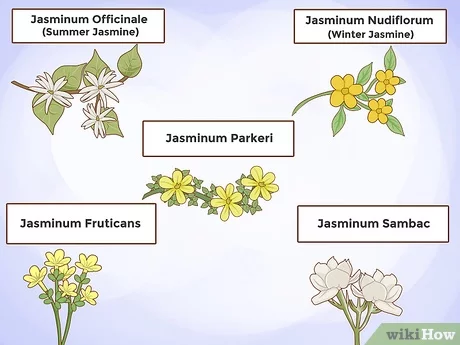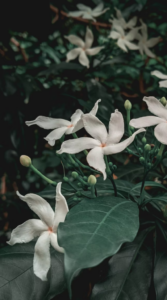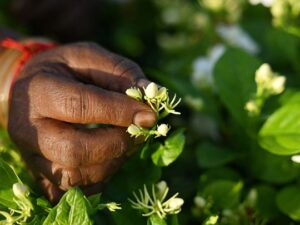Are you struggling to keep your jasmine plant alive and thriving? Look no further! This article will provide you with expert tips and tricks for growing and caring for jasmine, alleviating any concerns or problems you may have. Let’s dive in and discover the secrets to a flourishing jasmine plant.
What is Jasmine?
Jasmine is a fragrant flowering plant known for its beautiful white or yellow blossoms.[1] It belongs to the olive family and is native to tropical and warm temperate regions.[2] Jasmine plants typically have climbing or trailing vines and can grow up to 15 feet tall.[3] They are popular for their enchanting scent, often used in perfumes and teas.[4] To thrive, Jasmine requires full sun exposure and well-drained soil. Proper pruning and support are also essential for ensuring healthy growth.[6]
What are the Different Types of Jasmine Plants?
Jasmine is a beautiful and fragrant plant that comes in various types, each with its own unique characteristics. In this section, we will explore the different types of jasmine plants and their distinguishing features. From the classic white jasmine to the lesser-known pink jasmine, we will cover the common varieties as well as some more rare ones. By the end, you will have a better understanding of the diverse world of jasmine and which type may be best suited for your garden.
1. Common White Jasmine
Common White Jasmine, also known as Jasminum officinale, is a fragrant and popular variety of jasmine. Here are the steps to grow and care for this beautiful plant:
- Choose a sunny location with well-draining soil.
- Prepare the soil by mixing in organic matter like compost.
- Plant the Common White Jasmine in a hole twice as wide and deep as the root ball.
- Water the plant regularly, keeping the soil moist but not waterlogged.
- Fertilize the jasmine with a balanced fertilizer during the growing season.
- Prune the plant after flowering to maintain its shape and promote new growth.
- Trellis the plant to support its climbing habit.
- Protect the jasmine from common pests and diseases by monitoring and taking appropriate measures.
Growing Common White Jasmine can add beauty and a delightful fragrance to your garden.
2. Winter Jasmine
Winter jasmine (Jasminum nudiflorum) is a stunning flowering plant that thrives in the colder months. Its popularity stems from its ability to bring both color and fragrance to the winter landscape. This deciduous shrub produces bright yellow flowers on bare stems, making it a hardy and eye-catching addition to any winter garden.
To successfully grow winter jasmine, select a sunny location, prepare well-draining soil, and plant the jasmine. Proper care for winter jasmine includes:
- Regular watering
- Fertilizing in the spring
- Pruning after flowering
- Providing support for climbing
For maximum enjoyment, consider planting winter jasmine near a window or entrance to fully appreciate its vibrant blooms during the winter season.
3. Star Jasmine
Star Jasmine is a versatile and popular type of jasmine plant known for its beautiful, star-shaped flowers and sweet fragrance. Here are some key points to consider when growing Star Jasmine:
- Planting: Choose a location with well-drained soil and full sun to partial shade.
- Care: Water regularly, especially during hot, dry periods. Fertilize during the growing season to promote healthy growth.
- Support: Provide a trellis or support structure for the Star Jasmine vine to climb and spread.
- Pruning: Prune after flowering to maintain shape and control growth.
- Pests and Diseases: Watch out for common problems like aphids and powdery mildew. Use appropriate measures to prevent and treat these issues.
To ensure healthy and beautiful Star Jasmine plants, remember to provide proper care, regular maintenance, and monitor for any potential issues. Enjoy the stunning blooms and delightful fragrance that Star Jasmine brings to your garden.
4. Pink Jasmine
Pink Jasmine is a beautiful and fragrant type of jasmine plant that can be grown in your garden. It is one of several varieties of jasmine plants that are available.
When planting Pink Jasmine, make sure to choose a sunny spot with well-drained soil. Proper watering and fertilization are crucial for its growth. To care for Pink Jasmine, water it regularly, fertilize it during the growing season, prune it to maintain its shape, and provide support for it to climb on.
This lovely plant is a wonderful addition to any garden, attracting pollinators and filling the air with its delightful fragrance.
5. Arabian Jasmine
Arabian Jasmine is a popular type of jasmine plant known for its beautiful white flowers and intoxicating fragrance. To successfully grow and care for this plant, follow these steps:
- Choose a sunny location with well-drained soil.
- Prepare the soil by adding organic matter and ensuring proper drainage.
- Plant Arabian Jasmine in the desired location, making sure the root ball is level with the soil surface.
- Water regularly, keeping the soil consistently moist but not soggy.
- Fertilize every 2-3 months with a balanced fertilizer to promote healthy growth.
To keep Arabian Jasmine plants healthy and beautiful, remember to regularly prune to maintain shape, provide trellising or support for climbing varieties, and protect from common pests and diseases.
Incorporating Arabian Jasmine into your garden not only adds beauty but also provides a pleasant fragrance and attracts pollinators. Enjoy the benefits of growing this versatile and lovely plant.
How to Grow Jasmine?
Growing jasmine can bring a beautiful and fragrant addition to any garden. But, before you can enjoy the blooms and scent, you need to know how to properly grow jasmine. In this section, we will discuss the key steps to successfully grow jasmine. We will cover everything from selecting the perfect location to planting the jasmine in the soil. Follow these expert tips and tricks to ensure your jasmine thrives in your garden.
1. Choosing the Right Location
When it comes to the successful growth of jasmine plants, selecting the right location is crucial. Here are some steps to consider:
- Assess Sunlight Exposure: Jasmine plants thrive in full sun to partial shade, so it is important to choose a location that receives at least 4-6 hours of direct sunlight.
- Check Soil Drainage: Ensure that the soil has good drainage to prevent waterlogging, as jasmine plants do not tolerate soggy conditions.
- Consider Temperature and Climate: While most jasmine varieties prefer warm climates, they can also tolerate some cold. It is important to check the hardiness zone for your specific jasmine plant.
- Provide Support: As jasmine plants are climbers, choose a location with a trellis, fence, or wall for support.
- Consider Proximity: Plant jasmine near windows or outdoor seating areas to fully enjoy its delightful fragrance.
Jasmine has a rich history dating back centuries. It was highly prized in ancient civilizations like Egypt and Rome for its intoxicating scent and was used in perfumes, religious ceremonies, and medicinal remedies.
2. Preparing the Soil
Preparing the soil is an essential step in cultivating healthy jasmine plants. Follow these steps to properly prepare the soil:
- Test the soil pH: Jasmine prefers slightly acidic soil with a pH of 6 to 7. Adjust the pH if necessary.
- Clear the area: Remove any weeds, rocks, or debris that could impede plant growth.
- Loosen the soil: Use a garden fork or tiller to loosen the soil, allowing for better drainage and root penetration.
- Add organic matter: Incorporate compost or well-rotted manure into the soil to improve its fertility and structure.
- Mix in sand or perlite: Add sand or perlite to enhance drainage and prevent waterlogging.
- Ensure proper drainage: Make sure the soil has adequate drainage by creating raised beds or adding drainage materials.
- Level the soil: Smooth out the soil surface to create an even planting bed.
Properly preparing the soil creates a favorable environment for jasmine plants to thrive and produce beautiful blooms.
3. Planting Jasmine
To successfully plant jasmine, follow these steps:
- Choose a location that receives full sunlight or partial shade.
- Prepare the soil by removing weeds, loosening it, and adding organic matter.
- Dig a hole twice the width of the root ball and slightly deeper.
- Place the jasmine plant in the hole and backfill with soil, gently firming it around the roots.
- Water the plant deeply after planting to settle the soil.
Following these steps will ensure a healthy and thriving jasmine plant in your garden.
How to Care for Jasmine Plants?
Taking care of jasmine plants requires more than just watering them occasionally. Each aspect of care plays a crucial role in the health and growth of these delicate and fragrant flowers. In this section, we will discuss the essential steps to properly care for jasmine plants. From watering and fertilizing to pruning and trellising, we will provide expert tips and tricks to help your jasmine thrive. We will also cover how to protect your plants from common pests and diseases, ensuring they stay healthy and beautiful.
1. Watering
Proper watering is crucial for the health and growth of jasmine plants. Follow these steps to ensure proper watering:
- Water deeply: Make sure the soil is moistened to a depth of at least 6 inches.
- Frequency: Regularly water jasmine plants, especially during hot and dry periods.
- Avoid overwatering: Allow the soil to dry out slightly between watering sessions to prevent root rot.
- Use room temperature water: Using cold water can shock the roots, so it’s best to use water at room temperature.
- Apply water to the base: Direct the water at the base of the plant to avoid wetting the leaves, which can lead to fungal diseases.
Pro-tip: Mulching around the base of jasmine plants can help retain moisture and reduce the need for frequent watering.
2. Fertilizing
Fertilizing is a crucial step in the care of jasmine plants as it helps promote healthy growth and abundant blooms. To guide you through the process, here are the steps to fertilizing jasmine plants:
- Choose a balanced fertilizer with equal ratios of nitrogen, phosphorus, and potassium.
- Apply the fertilizer in early spring before new growth begins.
- Follow the instructions on the fertilizer packaging for the correct dosage.
- Spread the fertilizer evenly around the base of the plant, being careful not to let it come into direct contact with the stems or leaves.
- After fertilizing, water the plant thoroughly to help the nutrients penetrate the soil.
The practice of fertilizing plants has been around for centuries, with ancient civilizations recognizing the benefits of adding nutrients to the soil. Today, fertilizing is a commonly used gardening technique to nourish plants and improve their growth and vitality.
3. Pruning
Pruning jasmine plants is essential for their wellbeing and aesthetics. Follow these steps for proper pruning:
- Choose the right time: Prune jasmine plants in late winter or early spring before new growth begins.
- Prepare tools: Use clean and sharp pruning shears or scissors.
- Remove dead or damaged branches: Start by cutting off any dead or diseased branches at the base.
- Trim straggly growth: Trim back any long or leggy branches to promote a more compact and bushy shape.
- Shape the plant: Prune to create a desirable shape, such as a rounded or cascading form.
- Remove overcrowded branches: Cut out any branches that are crossing or overcrowding the center of the plant.
- Encourage new growth: Prune above a set of healthy leaves or buds to stimulate new growth.
Pruning jasmine plants is beneficial for promoting growth, improving air circulation, and maintaining their overall health and appearance.
4. Trellising
In order to properly support the growth and development of jasmine plants, trellising is an essential step. Here are the steps to trellis jasmine plants:
- Choose a sturdy trellis or support structure that can withstand the weight of the jasmine vines.
- Position the trellis or support system near the base of the jasmine plant, ensuring it is securely anchored to the ground.
- Gently guide the jasmine vines to climb and wrap around the trellis or support structure.
- Regularly monitor the growth of the vines and adjust their position on the trellis as necessary.
- Trim any excess growth and remove any dead or damaged branches to maintain the health and appearance of the jasmine plant.
Fact: In addition to providing support, trellising also enhances the aesthetic appeal of jasmine plants by creating a stunning vertical display of foliage and flowers.
5. Protecting from Pests and Diseases
To protect jasmine plants from pests and diseases, follow these steps:
- Regularly inspect the plants for any signs of infestation or disease.
- Remove any affected leaves or parts of the plant to prevent the spread of pests or diseases.
- Use organic insecticides or pesticides, such as neem oil, to control common pests like aphids or spider mites.
- Ensure proper watering and drainage to prevent root rot, a common issue in jasmine plants.
- Provide adequate air circulation by spacing the plants appropriately and avoiding overcrowding.
How to Propagate Jasmine Plants?
To propagate jasmine plants, follow these steps:
- Choose a healthy parent plant with strong stems and vibrant leaves.
- Select a softwood cutting that is 4-6 inches long.
- Remove the lower leaves, leaving 2-3 sets of leaves on the cutting.
- Dip the cut end of the cutting in rooting hormone powder.
- Plant the cutting in a well-draining potting mix, ensuring it is buried about 2 inches deep.
- Place the pot in a warm and bright location, away from direct sunlight.
- Keep the soil evenly moist, but not soggy, by watering regularly.
- After a few weeks, check for root development by gently tugging on the cutting. If there is resistance, roots have formed.
- Once roots have developed, transplant the cutting into a larger pot or directly in the garden.
- Continue to care for the new plant by providing it with adequate sunlight, water, and fertilizer.
What are the Benefits of Growing Jasmine Plants?
Why should you consider growing jasmine plants in your garden? The answer goes beyond the beautiful and delicate flowers that these plants produce. In this section, we will discuss the various benefits of growing jasmine, from its aromatic fragrance to its ability to attract pollinators. We’ll also explore the lesser-known medicinal uses of jasmine and how it can be a valuable addition to your herbal medicine cabinet. So, let’s dive into the world of jasmine and discover why it’s a must-have plant for any garden enthusiast.
1. Aromatic Fragrance
The sweet scent of jasmine plants adds a delightful ambiance to any garden or indoor space. To fully experience the fragrance, follow these steps:
- Choose a jasmine variety known for its strong aroma, such as Jasminum sambac or Arabian jasmine.
- Plant the jasmine in well-draining soil that is rich in organic matter.
- Place the jasmine in a sunny location to ensure optimal growth and production of its fragrance.
- Regularly water the plant, keeping the soil moist but not waterlogged.
- Fertilize the jasmine with a balanced fertilizer to promote healthy growth and enhance its aroma.
By following these steps, you can cultivate a jasmine plant that fills the air with its enchanting fragrance.
2. Attracts Pollinators
Jasmine plants are well-known for their stunning blooms and their ability to attract pollinators. To successfully attract pollinators to your jasmine plants, follow these steps:
- Choose the right variety: Certain species of jasmine, such as Arabian jasmine, are specifically known for attracting pollinators.
- Plant in the right location: Make sure your jasmine plants receive ample sunlight and are situated near other flowering plants that are known to attract pollinators.
- Provide a water source: Set up water dishes or create small water features near your jasmine plants to entice pollinators seeking hydration.
- Incorporate native plants: Including native plants in your garden can increase the likelihood of attracting local pollinators.
- Avoid pesticides: Use natural methods of pest control to avoid harming the pollinators that visit your jasmine plants.
By following these steps, you can create a welcoming environment for pollinators and appreciate the beauty of their presence in your garden.
3. Medicinal Uses
Jasmine plants have been recognized for their medicinal uses for centuries. By incorporating jasmine into your herbal remedies, you can experience various health benefits. Here are some steps to easily incorporate jasmine’s medicinal properties into your daily routine:
- Infuse jasmine flowers in hot water to create a calming and soothing tea.
- Use jasmine essential oil in aromatherapy to relieve stress and anxiety.
- Add jasmine oil to your skincare routine to promote healthy and radiant skin.
- Prepare jasmine oil blends to alleviate headaches and migraines.
- Apply jasmine oil topically to help reduce inflammation and muscle pain.
Incorporating jasmine’s medicinal uses into your daily life can provide a natural and effective way to support your overall well-being.
What are the Common Problems with Jasmine Plants and How to Solve Them?
As with any plant, jasmine can face its fair share of problems. In this section, we will discuss the common issues that jasmine plants may encounter and provide expert tips on how to solve them. Whether it’s yellowing leaves, lack of blooms, or pests and diseases, we’ve got you covered with solutions to keep your jasmine plant healthy and thriving. So let’s dive in and troubleshoot any problems you may be facing with your jasmine plant.
1. Yellowing Leaves
Yellowing leaves on jasmine plants can be a sign of various issues that need to be addressed. Here are steps to diagnose and treat yellowing leaves on jasmine plants:
- Check sunlight: Make sure the plant is receiving enough sunlight as insufficient light can result in yellowing leaves.
- Watering: Overwatering or underwatering can cause yellowing leaves. Adjust your watering routine accordingly.
- Soil quality: Poor drainage or nutrient deficiency can cause yellowing leaves. Improve soil drainage and consider fertilizing the plant.
- Pest infestation: Check for pests like aphids, mites, or whiteflies. If found, treat the plant with appropriate pesticides.
- Disease: Fungal or bacterial infections can cause yellowing leaves. Use specific treatments for the particular disease to address the issue.
2. Lack of Blooms
- Ensure Adequate Sunlight: Lack of blooms may be due to insufficient sunlight. Place jasmine plants in a location that receives at least 6 hours of direct sunlight per day.
- Optimal Temperature: Extreme temperatures can hinder blooming. Maintain a temperature range of 60-75°F (15-24°C) during the day and 40-60°F (4-15°C) at night.
- Proper Pruning: Regular pruning promotes blooming. Prune after flowering to remove dead wood and shape the plant.
- Appropriate Fertilization: Use a balanced fertilizer with higher phosphorus content to encourage blooming. Apply it every 4-6 weeks during the growing season.
- Adequate Watering: Overwatering can prevent blooms. Water deeply but allow the soil to dry out slightly between waterings.
Remember, patience is key when it comes to jasmine blooms. It may take some time for the plant to establish itself and start flowering. Be consistent with care and provide the necessary conditions, and you will soon enjoy beautiful blossoms.
3. Pests and Diseases
Pests and diseases can significantly impact the health of jasmine plants. To prevent and address these issues, follow these steps:
- Regularly inspect plants for signs of pests such as aphids, scales, or mealybugs.
- If pests are present, use natural remedies like insecticidal soap or neem oil to control them.
- Ensure proper drainage to avoid root rot and fungal diseases.
- Avoid overwatering, as this can create a favorable environment for disease development.
- Prune any damaged or infected plant parts and dispose of them properly.
By taking these precautions, you can protect your jasmine plants from common pests and diseases and promote their healthy growth.
What are Some Tips and Tricks for Growing Healthy and Beautiful Jasmine Plants?
To successfully grow healthy and beautiful jasmine plants, it is important to provide proper care and attention. Follow these tips and tricks for success:
- Choose a jasmine variety that is suitable for your climate and growing conditions.
- Plant jasmine in well-draining soil that is rich in organic matter.
- Ensure that the plants receive at least 6 hours of sunlight per day.
- Water regularly, keeping the soil consistently moist but not waterlogged.
- Prune jasmine regularly to promote bushier growth and remove any dead or damaged branches.
- Fertilize jasmine every 2-3 months with a balanced fertilizer to encourage healthy growth.
- Protect jasmine from extreme temperatures, frost, and strong winds.
- Monitor for pests and diseases and take necessary measures to control them.
- Support climbing jasmine varieties with trellises or stakes to ensure proper growth.
- Sit back and enjoy the beautiful blooms and fragrance of your healthy jasmine plants!
Frequently Asked Questions
1. What are some expert tips for growing jasmine?
To ensure successful growth of jasmine, make sure to plant it in well-drained soil with plenty of sunlight. Also, regularly prune and fertilize the plant to encourage healthy growth.
2. When is the best time to plant jasmine?
Jasmine should be planted in the spring or early summer when the soil is warm. This allows the plant to establish its roots before the colder months.
3. How often should I water my jasmine plant?
Jasmine plants should be watered regularly, especially during hot and dry weather. However, be careful not to overwater as this can lead to root rot. Allow the soil to dry out slightly between waterings.
4. How do I encourage my jasmine plant to bloom?
To encourage blooming, make sure your jasmine plant is receiving enough sunlight and is pruned regularly. Also, using a fertilizer specifically designed for flowering plants can help promote blooming.
5. Can jasmine be grown indoors?
Yes, jasmine can thrive indoors as long as it receives plenty of sunlight and is kept in a well-drained potting mix. However, be aware that it may not bloom as prolifically as it would outdoors.
6. What are some common pests and diseases to look out for when caring for jasmine?
Some common pests that can affect jasmine include aphids, scale insects, and spider mites. As for diseases, jasmine is susceptible to fungal diseases such as powdery mildew and root rot. Regularly inspect and treat your plant to prevent and control these issues.



